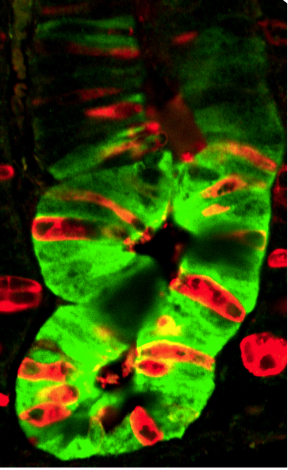We now know a lot about how the process of tissue regeneration gets started, and how to coax that process along to make repairs. But we know little about how to turn regeneration off, which is essential for keeping an organ at a normal size once the repair is complete. Finding that “off” switch may also be the key to halting growth of another kind: cancer.
Along with many other cancer researchers, Fernando Camargo, PhD, a researcher in the Boston Children’s Hospital Stem Cell Program, is hotly focused on a pathway called Hippo that’s known to regulate organ size. One member of this pathway, known as the “yes-associated protein” or YAP, has been found to say “yes” to growth so vigorously that activating it in mice makes the liver quadruple in size, as Camargo showed in 2007. YAP is also thought to be an oncogene, and has become a popular target in liver, ovarian and other cancers.
But Camargo, research fellow Evan Barry, PhD, and their colleagues recently found that saying “no” to YAP might not always be a good idea.
They looked at regeneration in the intestine, diving down into the crypts. In these deep chambers, intestinal stem cells churn out the cells that maintain the villi—those fingerlike protrusions that absorb what we eat. As the stem cells multiply, they push young progenitor cells up toward the villi tips (as illustrated beautifully in this video). Along the way, these cells make more specialized daughters and granddaughters, which take the place of older, dying cells when they reach the top.
When Camargo and Barry removed YAP in a mouse model, they didn’t find restricted regeneration, as they expected. Instead, they found the opposite: an overgrowth of intestinal stem cells and dramatically expanded crypt regions. Some crypts had developed small tumors, or microadenomas, and some even had new crypts sprouting off them.
When the researchers added more YAP, regeneration and stem-cell expansion ground to a halt, and there was a rapid loss of crypts. “This tells us that what might be growth-activating in one organ might be inhibitory in another,” says Camargo. “Growth control is hardwired differently in each tissue.”
Colorectal cancer does seem to be a different case from liver or ovarian cancer. Looking at 672 colorectal cancer samples, the researchers found that patients whose tumors lacked YAP activity (about 10 percent of the samples) tended to have worse survival and were more likely to have high-grade, stage IV disease.
In short, they provide evidence that YAP is silenced in highly aggressive, undifferentiated human colorectal carcinoma—and that activating YAP could stop those carcinomas from growing.
Why are YAP’s dynamics different in the intestine? Camargo thinks that different organs have different sets of checks and balances that regulate growth—both regenerative and cancerous. In the case of the intestine, YAP inhibits another growth-promoting pathway, the Wnt pathway, by controlling a molecule known as disheveled—thereby counterbalancing growth signals.
“The design of therapeutic strategies targeting the Hippo/YAP pathway needs to be based on a detailed understanding of the molecules and how they behave in context,” Camargo says. “You need an organ-specific approach.”
Camargo also thinks contextual factors are important, like where key molecules are located in the cell and how the cell controls where they go. “We don’t know all the players yet, but the best thing to do may be to manipulate YAP’s localization in the cell, and get it to go from the nucleus to the cytoplasm,” he says. “But strategies that seek to diminish expression of YAP altogether are probably not advisable.”







